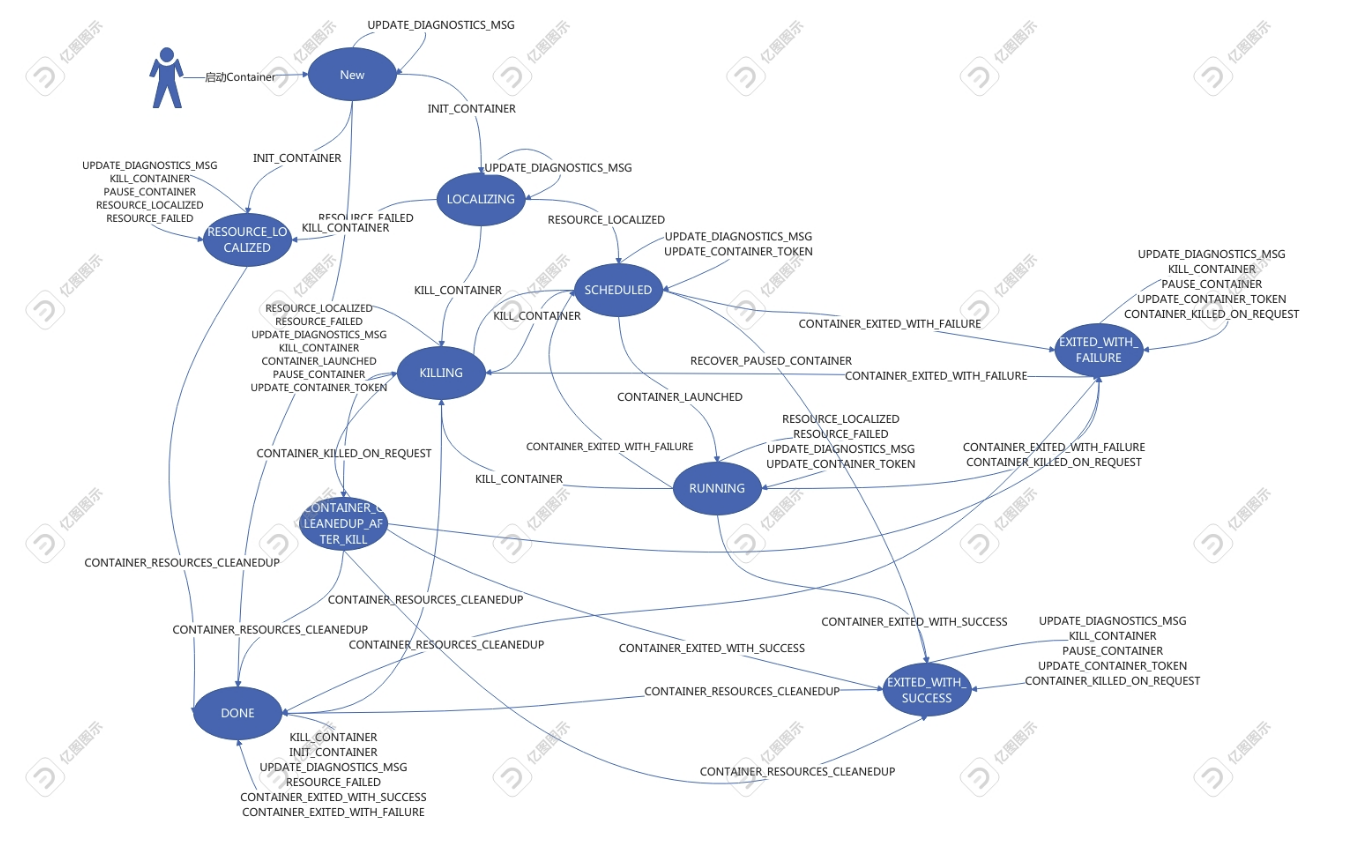174 lines
6.3 KiB
Markdown
174 lines
6.3 KiB
Markdown
|
||
# 简介
|
||
ContainerManager主要负责NM中管理所有Container生命周期,其主要包含启动Container、恢复Container、停止Container等功能。
|
||
主要功能由ContainerManagerImpl类实现,具体代码可以参考当前类。
|
||
|
||
# 初始化
|
||
|
||
初始化主要分为两部分:
|
||
|
||
ContainerManagerImpl实例的构造函数和serviceInit函数。
|
||
|
||
## 构造函数
|
||
当前函数为构造函数,主要初始化必须要的一些变量等。
|
||
|
||
- dispatcher : 事件的中央调度器,主要用于管理单个Container的生命周期。在当前函数里面会通过`dispatcher.register()`注册支持的事件。
|
||
|
||
- containersLauncher: 主要用于启动Container,可以通过配置项yarn.nodemanager.containers-launcher.class指定。默认为containersLauncher.class
|
||
|
||
|
||
## serviceInit函数
|
||
|
||
主要是服务启动时的初始化函数,ContainerManager在NodeManager内部属于一个服务。所以初始化的时候会调用这个函数初始化一些服务相关的东西。
|
||
|
||
在这个函数里面总结下来主要做了几件事:
|
||
- 继续初始化一些事件,主要包含LogHandlerEventType、SharedCacheUploadEventType。
|
||
- 初始化AMRMProxyService。
|
||
- 从本地的LevelDB恢复Container信息。
|
||
|
||
### 恢复当前NodeManager的所有作业信息
|
||
|
||
|
||
#### 第一步:恢复Application 信息
|
||
|
||
首先是从LevelDB里面加载Application信息。循环加载。
|
||
|
||
```java
|
||
RecoveredApplicationsState appsState = stateStore.loadApplicationsState();
|
||
try (RecoveryIterator<ContainerManagerApplicationProto> rasIterator =
|
||
appsState.getIterator()) {
|
||
while (rasIterator.hasNext()) {
|
||
ContainerManagerApplicationProto proto = rasIterator.next();
|
||
LOG.debug("Recovering application with state: {}", proto);
|
||
recoverApplication(proto);
|
||
}
|
||
}
|
||
```
|
||
|
||
加载Application的时候会将Application的上下文信息从LevelDB里面读出来,通过上下文信息等初始化新的ApplicationImpl,并且触发ApplicationInitEvent事件。
|
||
会根据当前作业上下文中实际的状态等信息跳转到实际的状态。
|
||
|
||
```java
|
||
ApplicationImpl app = new ApplicationImpl(dispatcher, p.getUser(), fc,
|
||
appId, creds, context, p.getAppLogAggregationInitedTime());
|
||
context.getApplications().put(appId, app);
|
||
metrics.runningApplication();
|
||
app.handle(new ApplicationInitEvent(appId, acls, logAggregationContext));
|
||
```
|
||
|
||
#### 第二步:恢复所有的Container信息
|
||
|
||
第二步是从LevelDB里面加载Container信息。循环加载。
|
||
|
||
```java
|
||
try (RecoveryIterator<RecoveredContainerState> rcsIterator =
|
||
stateStore.getContainerStateIterator()) {
|
||
while (rcsIterator.hasNext()) {
|
||
RecoveredContainerState rcs = rcsIterator.next();
|
||
LOG.debug("Recovering container with state: {}", rcs);
|
||
recoverContainer(rcs);
|
||
}
|
||
}
|
||
```
|
||
|
||
recoverContainer函数用于恢复单个Container信息。对于已经存在的Application对应的Container会通过LevelDB里面加载到的信息初始化Container对象,
|
||
将其加到所有Container的列表里面并且触发ApplicationContainerInitEvent,后续会根据实际状态信息跳转到指定状态继续处理。
|
||
|
||
```java
|
||
Container container = new ContainerImpl(getConfig(), dispatcher,
|
||
launchContext, credentials, metrics, token, context, rcs);
|
||
context.getContainers().put(token.getContainerID(), container);
|
||
containerScheduler.recoverActiveContainer(container, rcs);
|
||
app.handle(new ApplicationContainerInitEvent(container));
|
||
```
|
||
|
||
如果发现作业的状态为KILL状态,则会为当前Container重新触发KILL事件,保证Container已经停止。
|
||
|
||
对于Application找不见的Container,认为作业已经结束了,直接标记为已经完成。
|
||
|
||
|
||
在恢复完成之后会触发事件: ContainerSchedulerEventType.RECOVERY_COMPLETED
|
||
|
||
此状态会重新拉起所有的Container。
|
||
|
||
|
||
# 启动Containers
|
||
|
||
## 获取NMToken
|
||
|
||
在Container启动之前需要获取NMToken,可以通过下面命令获取,一般情况下获取第一个NMTokenIdentifier类型的Token。
|
||
|
||
```java
|
||
Set<TokenIdentifier> tokenIdentifiers = remoteUgi.getTokenIdentifiers();
|
||
```
|
||
|
||
## 开始启动Container
|
||
|
||
启动之前需要做的就是初始化ContainerImpl信息,方便后续启动Container。
|
||
|
||
```java
|
||
Container container =
|
||
new ContainerImpl(getConfig(), this.dispatcher,
|
||
launchContext, credentials, metrics, containerTokenIdentifier,
|
||
context, containerStartTime);
|
||
|
||
```
|
||
|
||
如果是第一次启动(满足条件:`!context.getApplications().containsKey(applicationID))`,也就是AM,会通过下面命令触发作业的启动:
|
||
|
||
```java
|
||
context.getNMStateStore().storeApplication(applicationID,
|
||
buildAppProto(applicationID, user, credentials, appAcls,
|
||
logAggregationContext, flowContext));
|
||
dispatcher.getEventHandler().handle(new ApplicationInitEvent(
|
||
applicationID, appAcls, logAggregationContext));
|
||
```
|
||
|
||
满足下面条件则是恢复Application:
|
||
|
||
`containerTokenIdentifier.getContainerType() == ContainerType.APPLICATION_MASTER && context.getApplications().containsKey(applicationID))`
|
||
|
||
启动Container主要是触发Container的Init事件:
|
||
|
||
```java
|
||
this.context.getNMStateStore().storeContainer(containerId,
|
||
containerTokenIdentifier.getVersion(), containerStartTime, request);
|
||
dispatcher.getEventHandler().handle(
|
||
new ApplicationContainerInitEvent(container));
|
||
```
|
||
|
||
# 停止Container
|
||
|
||
## 获取NMToken
|
||
|
||
在Container停止之前需要获取NMToken,可以通过下面命令获取,一般情况下获取第一个NMTokenIdentifier类型的Token。和启动时候的类似。
|
||
|
||
```java
|
||
Set<TokenIdentifier> tokenIdentifiers = remoteUgi.getTokenIdentifiers();
|
||
```
|
||
|
||
## 停止作业
|
||
|
||
停止作业的时候会优先通过`context.getContainers().get(containerID)`获取Container信息。
|
||
|
||
如下场景会抛出异常:
|
||
- 对于查询不到的Container,如果不是最新停止的,则会抛出异常。
|
||
- 对于正在恢复的Container,不会接受停止,会抛出异常。
|
||
|
||
|
||
停止作业的核心逻辑如下,核心思想是触发KILL事件。具体可以参见[Container事件处理](#Container事件处理)
|
||
```java
|
||
context.getNMStateStore().storeContainerKilled(containerID);
|
||
container.sendKillEvent(ContainerExitStatus.KILLED_BY_APPMASTER,
|
||
"Container killed by the ApplicationMaster.");
|
||
```
|
||
|
||
# Container事件处理
|
||
|
||
Container启动的开始是从事件InitContainerTransition。由当前事件通过状态机转到其他状态。
|
||
|
||
|
||

|
||
|
||
|